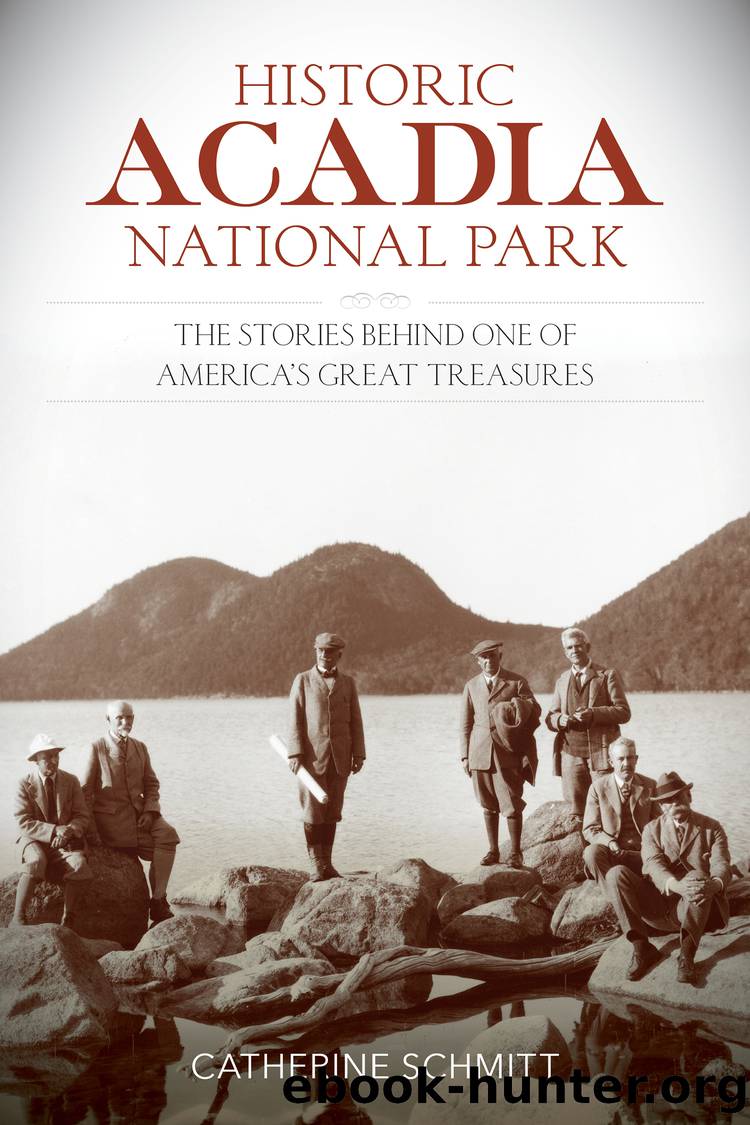Historic Acadia National Park by Schmitt Catherine;

Author:Schmitt, Catherine; [Schmitt, Catherine]
Language: eng
Format: epub
Publisher: Lyons Press
Published: 2016-09-15T00:00:00+00:00
George Dorr recognized the importance of Acadia to science, and vice versa. At the dedication ceremony for Sieur de Monts National Monument in 1916, Dorr said that the park should be âa sanctuary and protecting homeâ for the whole regionâs plant and animal life. âMake it this, and naturalists will seek it from the whole world over, and from it other men will learn similarly to cherish wild life in other places.â
Dorr had support from scientists. Merritt Fernald, who was from Maine and chaired the Botany Department at Harvard, wrote in a letter in support of federal protection that Acadia was the best single area he knew for preserving and exhibiting a wide range of northeastern US plants.
Mount Desert offered similar opportunities for birdlife, according to Ernest Howe Forbush, state ornithologist of Massachusetts, who conducted a study of Acadiaâs birds. T. Gilbert Pearson, cofounder and secretary of the National Association of Audubon Societies, stated in his letter that in all the years his association had been engaged in seeking to establish refuges or sanctuaries for wild birdlife, âno area in the East of such importance to wild life, bird or other, has been set aside as sanctuary as that contained within the borders of the Sieur de Monts National Monument.â
In their push to have the national monument expanded to national park status, Dorr, Forbush, and Fernald wrote in National Geographic:
The only way in which to conserve for the enjoyment and study of future generations any portions of our country which by good fortune are still somewhat in their natural condition is the reservation of all such tracts as may properly be set aside, with the explicit stipulation that they be left essentially in the hands of Nature herself to care for. This brings me to the crucial point: where is the best spot, if only a single spot can be thus preserved, for the perfection of this ideal? . . . As a single area within the possible reach of this hope, the Island of Mount Desert, with its adjacent islets and headlands, stands out as offering the greatest natural diversity.
When President Woodrow Wilson established the national monument, he cited first the historic connection to Samuel de Champlain and then, in the same paragraph, âThe topographic configuration, the geology, the fauna and the flora of the island, largely embraced within the limits of the Monument, also, are of great scientific interest.â
For Dorr, speaking at the dedication of the national monument, the history of scientific work on the island foretold the parkâs future:
During the early summer, when I was at Washington working on this matter of the Parkâs establishment and was plunged for weeks together in its oppressive heat, it struck me what a splendid and useful thing it would be if we could provide down here, in a spot so full of biologic interest and unsolved biologic problems, so rich in various beauty and locked around by a cool northern sea, a summer campâsome simple summer homeâfor men of science working in the government bureaus, in the museums and universities.
Download
This site does not store any files on its server. We only index and link to content provided by other sites. Please contact the content providers to delete copyright contents if any and email us, we'll remove relevant links or contents immediately.
Eating Animals by Foer Jonathan Safran(644)
J. M. Coetzee and Ethics by Anton Leist(593)
Cats by Unknown(550)
Tears of Battle by Brigitte Bardot(500)
Rescue Ink by Rescue Ink(485)
Pigs of Paradise by T. R. Todd(386)
Run, Spot, Run: The Ethics of Keeping Pets by Jessica Pierce(382)
Kindness for All Creatures by Sarah C. Beasley & Anam Thubten(366)
Food and Nutrition by Unknown(356)
Simple Recipes for Joy by Sharon Gannon(355)
Wild Horse Annie and the Last of the Mustangs by David Cruise & Alison Griffiths(328)
Animals and Women: Feminist Theoretical Explorations by Carol J. Adams & Josephine Donovan(315)
Veganism, Sex and Politics: Tales of Danger and Pleasure by C. Lou Hamilton(304)
How to Count Animals, more or less by Shelly Kagan(277)
Prison Dog Programs by Mary Renck Jalongo(276)
The Routledge Handbook of Animal Ethics by Bob Fischer;(226)
Making a Killing by Bob Torres(221)
The Joyful Vegan by Colleen Patrick-Goudreau(217)
Our Symphony with Animals by Aysha Akhtar(216)
